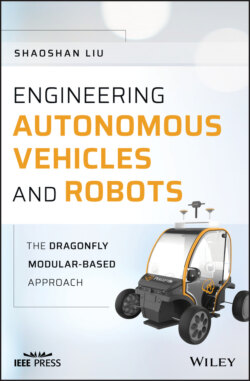Engineering Autonomous Vehicles and Robots

Реклама. ООО «ЛитРес», ИНН: 7719571260.
Оглавление
Shaoshan Liu. Engineering Autonomous Vehicles and Robots
Table of Contents
List of Tables
List of Illustrations
Guide
Pages
Engineering Autonomous Vehicles and Robots. The DragonFly Modular-based Approach
1 Affordable and Reliable Autonomous Driving Through Modular Design. 1.1 Introduction
1.2 High Cost of Autonomous Driving Technologies
1.2.1 Sensing
1.2.2 HD Map Creation and Maintenance
1.2.3 Computing Systems
1.3 Achieving Affordability and Reliability
1.3.1 Sensor Fusion
1.3.2 Modular Design
1.3.3 Extending Existing Digital Maps
1.4 Modular Design
1.4.1 Communication System
1.4.2 Chassis
1.4.3 mmWave Radar and Sonar for Passive Perception
1.4.4 GNSS for Localization
1.4.5 Computer Vision for Active Perception and Localization
1.4.6 Planning and Control
1.4.7 Mapping
1.5 The Rest of the Book
1.6 Open Source Projects Used in this Book
References
2 In-Vehicle Communication Systems. 2.1 Introduction
2.2 CAN
2.3 FlexRay
2.3.1 FlexRay Topology
2.3.2 The FlexRay Communication Protocol
2.4 CANopen
2.4.1 Object Dictionary
2.4.2 Profile Family
2.4.3 Data Transmission and Network Management
2.4.4 Communication Models
2.4.5 CANopenNode
References
3 Chassis Technologies for Autonomous Robots and Vehicles. 3.1 Introduction
3.2 Throttle-by-Wire
3.3 Brake-by-Wire
3.4 Steer-by-Wire
3.5 Open Source Car Control
3.5.1 OSCC APIs
3.5.2 Hardware
3.5.3 Firmware
3.6 OpenCaret
3.6.1 OSCC Throttle
3.6.2 OSCC Brake
3.6.3 OSCC Steering
3.7 PerceptIn Chassis Software Adaptation Layer
References
4 Passive Perception with Sonar and Millimeter Wave Radar. 4.1 Introduction
4.2 The Fundamentals of mmWave Radar
4.2.1 Range Measurement
4.2.2 Velocity Measurement
4.2.3 Angle Detection
4.3 mmWave Radar Deployment
4.4 Sonar Deployment
References
5 Localization with Real-Time Kinematic Global Navigation Satellite System. 5.1 Introduction
5.2 GNSS Technology Overview
5.3 RTK GNSS
5.4 RTK-GNSS NtripCaster Setup Steps
5.4.1 Set up NtripCaster
5.4.2 Start NtripCaster
5.5 Setting Up NtripServer and NtripClient on Raspberry Pi. 5.5.1 Install the Raspberry Pi System
5.5.2 Run RTKLIB-str2str on the Raspberry Pi. 5.5.2.1 Running NtripServer on the Base Station Side
5.5.2.2 Running NtripClient on the GNSS Rover
5.6 Setting Up a Base Station and a GNSS Rover. 5.6.1 Base Station Hardware Setup
5.6.2 Base Station Software Setup
5.6.3 GNSS Rover Setup. 5.6.3.1 Rover Hardware Setup
5.6.3.2 Rover Software Setup
5.7 FreeWave Radio Basic Configuration
References
6 Computer Vision for Perception and Localization. 6.1 Introduction
6.2 Building Computer Vision Hardware
6.2.1 Seven Layers of Technologies
6.2.2 Hardware Synchronization
6.2.3 Computing
6.3 Calibration
6.3.1 Intrinsic Parameters
6.3.2 Extrinsic Parameters
6.3.3 Kalibr
6.3.3.1 Calibration Target
6.3.3.2 Multiple Camera Calibration
6.3.3.3 Camera IMU Calibration
6.3.3.4 Multi-IMU and IMU Intrinsic Calibration
6.4 Localization with Computer Vision
6.4.1 VSLAM Overview
6.4.2 ORB-SLAM2
6.4.2.1 Prerequisites
6.4.2.2 Building the ORB-SLAM2 Library
6.4.2.3 Running Stereo Datasets
6.5 Perception with Computer Vision
6.5.1 ELAS for Stereo Depth Perception
6.5.2 Mask R-CNN for Object Instance Segmentation
6.6 The DragonFly Computer Vision Module
6.6.1 DragonFly Localization Interface
6.6.2 DragonFly Perception Interface
6.6.3 DragonFly+
References
7 Planning and Control. 7.1 Introduction
7.2 Route Planning
7.2.1 Weighted Directed Graph
7.2.2 Dijkstra's Algorithm
7.2.3 A* Algorithm
7.3 Behavioral Planning
7.3.1 Markov Decision Process
7.3.2 Value Iteration Algorithm
7.3.3 Partially Observable Markov Decision Process (POMDP)
7.3.4 Solving POMDP
7.4 Motion Planning
7.4.1 Rapidly Exploring Random Tree
7.4.2 RRT*
7.5 Feedback Control
7.5.1 Proportional–Integral–Derivative Controller
7.5.2 Model Predictive Control
7.6 Iterative EM Plannning System in Apollo
7.6.1 Terminologies. 7.6.1.1 Path and Trajectory
7.6.1.2 SL Coordinate System and Reference Line
7.6.1.3 ST Graph
7.6.2 Iterative EM Planning Algorithm
7.6.2.1 Traffic Decider
7.6.2.2 QP Path and QP Speed
7.7 PerceptIn's Planning and Control Framework
References
8 Mapping. 8.1 Introduction
8.2 Digital Maps
8.2.1 Open Street Map
8.2.1.1 OSM Data Structures
8.2.1.2 OSM Software Stack
8.2.2 Java OpenStreetMap Editor
8.2.2.1 Adding a Node or a Way
8.2.2.2 Adding Tags
8.2.2.3 Uploading to OSM
8.2.3 Nominatim
8.2.3.1 Nominatim Architecture
8.2.3.2 Place Ranking in Nominatim
8.3 High-Definition Maps
8.3.1 Characteristics of HD Maps. 8.3.1.1 High Precision
8.3.1.2 Rich Geometric Information and Semantics
8.3.1.3 Fresh Data
8.3.2 Layers of HD Maps
8.3.2.1 2D Orthographic Reflectivity Map
8.3.2.2 Digital Elevation Model
8.3.2.3 Lane/Road Model
8.3.2.4 Stationary Map
8.3.3 HD Map Creation
8.3.3.1 Data Collection
8.3.3.2 Offline Generation of HD Maps
8.3.3.3 Quality Control and Validation
8.3.3.4 Update and Maintenance
8.3.3.5 Problems of HD Maps
8.4 PerceptIn's π-Map
8.4.1 Topological Map
8.4.2 π-Map Creation
References
9 Building the DragonFly Pod and Bus. 9.1 Introduction
9.2 Chassis Hardware Specifications
9.3 Sensor Configurations
9.4 Software Architecture
9.5 Mechanism
9.6 Data Structures
9.6.1 Common Data Structures
Common.proto
Geometry.proto
9.6.2 Chassis Data
Chassis.proto
9.6.3 Localization Data
Localization.proto
9.6.4 Perception Data
Perception.proto
9.6.5 Planning Data
Decision.proto
Planning.proto
9.7 User Interface
References
10 Enabling Commercial Autonomous Space Robotic Explorers. 10.1 Introduction
10.2 Destination Mars
10.3 Mars Explorer Autonomy
10.3.1 Localization
10.3.2 Perception
10.3.3 Path Planning
10.3.4 The Curiosity Rover and Mars 2020 Explorer
10.4 Challenge: Onboard Computing Capability
10.5 Conclusion
References
11 Edge Computing for Autonomous Vehicles. 11.1 Introduction
11.2 Benchmarks
11.3 Computing System Architectures
11.4 Runtime
11.5 Middleware
11.6 Case Studies
References
12 Innovations on the Vehicle-to-Everything Infrastructure. 12.1 Introduction
12.2 Evolution of V2X Technology
12.3 Cooperative Autonomous Driving
12.4 Challenges
References
13 Vehicular Edge Security. 13.1 Introduction
13.2 Sensor Security
13.3 Operating System Security
13.4 Control System Security
13.5 V2X Security
13.6 Security for Edge Computing
References
Index
WILEY END USER LICENSE AGREEMENT
Отрывок из книги
Shaoshan Liu
Fremont, CA
.....
Creating and maintaining HD maps is another important component of deployment costs. Crowd-sourcing the data for creating HD maps has been proposed. However, this would require vehicles with LiDAR units, and we have already seen that LiDARs are extremely expensive and thus not ready for large-scale deployment. On the other hand, crowd-sourcing visual data is a very practical solution as many cars today are already equipped with cameras.
Hence, instead of building HD maps from scratch, our philosophy is to enhance existing digital maps with visual information to achieve decimeter-level accuracy. These are called HPVMs. To effectively help with vehicle localization, HPVMs consists of multiple layers:
.....